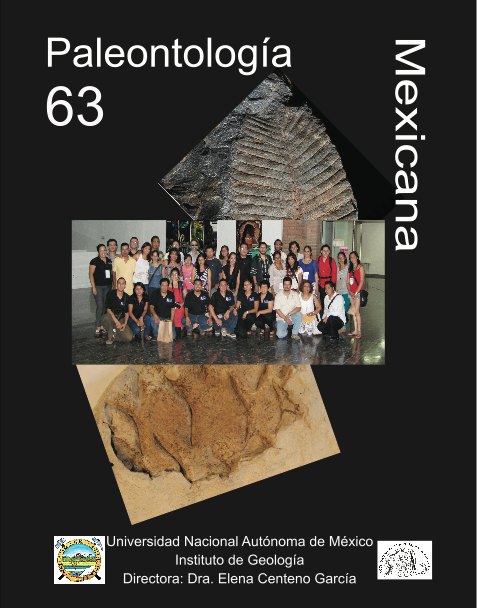Pinaceae in the Cretaceous of northern and southern Mexico: a complement to its scarce fossil record
Main Article Content
Abstract
The diversity and richness of fossil conifers in Mexico is poorly known and its presence since the Cretaceous is sporadic, although they have been documented since the first half of last century. In Mexico part of the history of certain groups of conifers has been documented, but it has been enriched in recent years by the collection of well-preserved specimens in Cretaceous sediments in the states of Sonora and Chiapas. The fossil specimens were observed under a stereoscopic microscope and ultraviolet light. Based on observation and comparison of morphological characters affinities are established with Pinaceae. “El Chango” is located near to the Municipality of Ocozocoautla, Chiapas, and is characterized by the presence of fish, arthropods, and cephalopods and especially of plants (gymnosperms dominate on angiosperms) preserved in Aptian-Cenomanian sediments. The new material consists of two branches with leaves, a female and male cone with Pinaceae affinity, although this latter is also compared with Podocarpaceae and Cupressaceae. The “Esqueda” locality in the town of Fronteras, Sonora, is characterized mainly by the presence of footprints and dinosaur bones preserved in sediments of Late Campanian age. The material from this locality consists of two branches with leaves and a female cone of which rubber molds were extracted, with affinity to Pinaceae. This new material extends the historical and geographical information of Pinaceae, the most successful family of conifers today. Mexico plays an important role in the diversification of Pinus, as nearly 50% of its species are concentrated in the country. This fact makes it even more important to supplement the fossil record of the group, which in Mexico becomes rich from the Oligocene / Miocene (ca. 32 Ma.)
Article Details

This work is licensed under a Creative Commons Attribution-NonCommercial-NoDerivatives 4.0 International License.
References
Alvarado-Ortega, J.E., Ovalles-Damián y A. Blanco-Piñón. 2009. The Fossil Fishes from the Sierra Madre Formation, Ocozocoautla, Chiapas, Southern Mexico. Paleontología Electrónica 12(2.4 A): 1-22.
Campos, J.L. 1993. Claves para la Determinación de los Pinos Mexicanos. Universidad Autónoma de Chapingo. México. 70 pp.
Cevallos-Ferriz, S.R.S. 1992. Tres maderas de gimnospermas cretácicas del norte de México. Anales Inst. Biol. Univ. Nac. Autón. México, Ser. Bot. 63(2): 111-137.
Cevallos-Ferriz, S.R.S., E.A. González-Torres y L. Calvillo-Canadell. 2012. Perspectiva paleobotánica y geológica de la biodiversidad en México. Acta Botánica Mexicana 100: 317-350.
Cleal, C.J. y B.A. Thomas. 2009. Introduction to Plant Fossils. Cambridge University Press. Nueva York. 237 pp.
Christenhusz, M.J.M., J.L. Reveal, A. Farjon, M.F. Gardner, R.R. Mill y M.W. Chase. 2011. A new classification and linear sequence of extant gymnosperms. Phytotaxa 19: 55-70.
González-Ramírez, I., Calvillo-Canadell, L., Silva-Pineda, A. y Cevallos-Ferriz, S.R.S. 2011. Coníferas (Araucariaceae y Cupressaceae) del Cretácico (Aptiano-Campaniano) de Chiapas (resumen), en: Libro de resúmenes del XII Congreso Nacional de Paleontología, Puebla, México. Sociedad Mexicana de Paleontología, 68.
Domènech, R. y J. Martinell. 1996. Introducción a los Fósiles. Masson. Barcelona. 288 pp.
Eckenwalder, J.E. 2009. Conifers of the World. Timber Press. Portland, Ore. 720 pp.
Eckert, A.J. y B.D. Hall. 2006. Phylogeny, historical biogeography, and patterns of diversification for Pinus (Pinaceae): Phylogenetic tests of fossil-based hypotheses. Molecular Phylogenetics and Evolution 40: 166-182.
Farjon, A. 2008. A Natural History of Conifers. Timber Press. Portland, Ore. 304 pp.
Millar, C.I. 1993. Impact of the Eocene on the Evolution of Pinus L. Annals of the Missouri Botanical Garden 80(2): 471-498.
Pérez-Rodríguez, P.M. 2008. Claves de Determinación Botánica (con énfasis en familias de árboles). Universidad Autónoma de Chapingo. Chapingo, México. 307 pp.
Serlin, B.S., T. Delevoryas y R. Weber. 1981. A new conifer pollen cone from the Upper Cretaceous of Coahuila, Mexico. Review of Paleobotany and Palynology 31: 241-248.
Servín-Pichardo, R., Hernández-Rivera, R., González-León, C.M. y Pacheco-Rodríguez, R. 2011. Primer registro de dinosauricnitas en el Grupo Cabullona (Cretácico Tardío), Esqueda, Municipio de Fronteras, Sonora (resumen), en: Libro de resúmenes del XII Congreso Nacional de Paleontología, Puebla, México. Sociedad Mexicana de Paleontología, 30.
Simpson, M.G. 2010. Plant Systematics. 2da ed. Academic Press. USA. 740 pp.
Syring, J., A. Willyard, R. Cronn y A. Liston. 2005. Evolutionary relationships among Pinus (Pinaceae) subsections inferred from multiple low-copy nuclear loci. American Journal of Botany 92(12): 2086-2100.
Than-Marchese, B.A., Alvarado-Ortega, J. y Carbot-Chanona, G. 2011. Notas adicionales sobre la ictiofauna cretácica de Chiapas (resumen), en: Libro de resúmenes del XII Congreso Nacional de Paleontología, Puebla, México. Sociedad Mexicana de Paleontología, 135.
Weber, R. 1975. Aachenia knoblochii n. sp., an interesting conifer from the Upper Cretaceous Olmos Formation of northeastern Mexico. Paleontographica 152B: 76-83.
Weber, R. 1980. Megafósiles de Coníferas del Triásico Tardío y del Cretácico Tardío de México y Consideraciones Generales sobre las Coníferas Mesozoicas de México. Univ. Nal. Autón. México, Inst. Geología, Revista 4(2): 111-124.
Páginas web
Botánica morfológica. 2001. Flor masculina (en línea): Corrientes, Argentina. Actualizado en 2008. Disponible en http://www.biologia.edu.ar/botanica/animaciones/ciclos/pino/paginaspino/flormasc.html. Consultado el 7 de diciembre de 2012.
Botánica morfológica. 2001. Organización del cuerpo de las plantas: Diferenciación morfológica del tallo, hoja y raíz (en línea): Corrientes, Argentina. Actualizado en 2008. Disponible en http://agr.unne.edu.ar/botanica/tema1/1-2tallo.htm. Consultado el 7 de diciembre de 2012.
Botánica morfológica. 2001. Ramas (en línea): Corrientes, Argentina. Actualizado en 2012. Disponible en http://agr.unne.edu.ar/botanica/animaciones/ciclos/pino/paginaspino/hoja%20myb.html. Consultado el 7 de diciembre de 2012.
Enciclopedia de los Municipios y Delegaciones de México. 2010. Estado de Sonora (en línea): México, INAFED Instituto para el Federalismo y el Desarrollo Municipal. Disponible en http://www.e-local.gob.mx/work/templates/enciclo/EMM26sonora/municipios/26027a.html. Consultado el 7 de diciembre de 2012.
GoldenMap. 2011. Keteleeria evelyniana (en línea): Barcelona, España. Disponible en http://es.goldenmap.com/Keteleeria_evelyniana. Consultado el 7 de diciembre de 2012.
Interactive Flora of NW Europe. Larix decidua (Larch, European) (en línea): C. Stace, R. van der Meijden (ed.) & I. de Kort (ed.). Disponible en http://wbd.etibioinformatics.nl/bis/flora.php?menuentry=soorten&id=1554. Consultado el 8 de abril de 2013.
Orchids BONSAI Forum. Các loài thuộc họ thông tại Việt Nam (en línea). Disponible en http://hoalancaycanh.com/diendan/cay-la-kim-thong-tung-la-han/3367-cac-loai-thuoc-ho-thong-tai-viet-nam.html?langid=1. Consultado el 7 de diciembre de 2012.
The Gymnosperm Database. 2013. Pinaceae (en línea): J. Earle, C. Actualizado el 22 de marzo de 2013. Disponible en http://www.conifers.org/pi/Pinaceae.php. Consultado el 8 de abril de 2013.
